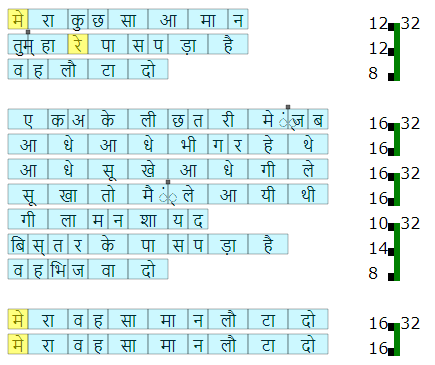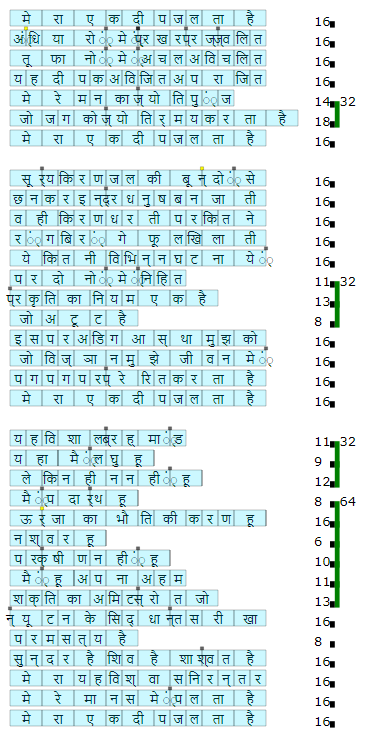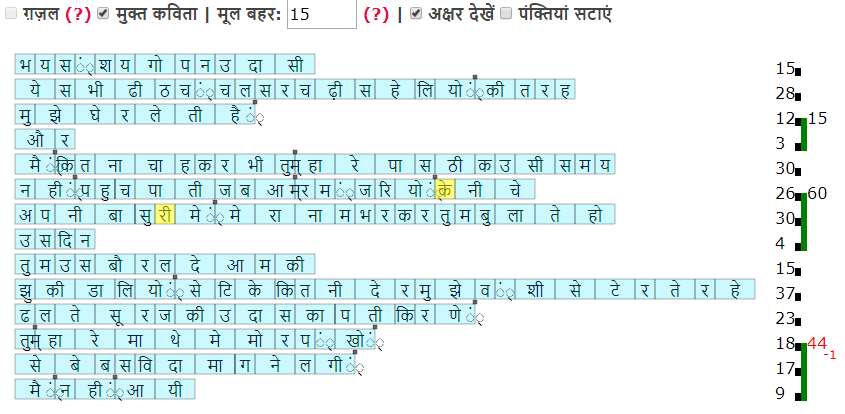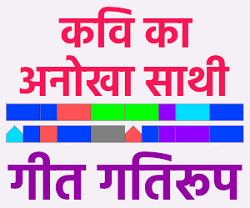Basic Structure of Hindi Poetry
Part 3a - GeetGatiroop software for Mukt-Kavita
Vani Murarka and Vinod Tewary
(Editors, Kaavyaalaya.org)
Email address: [email protected]
Preface
This is an addendum to Part 3 of the series of articles on the basic structure of Hindi poetry. That part dealt with the role and importance of rhythm in Free Verse (Mukt-Kavita). Also, Part 2a illustrated the use of GeetGatiroop, a powerful software tool, for analyzing and visualizing the rhythm of a Hindipoem. This tool, developed by Vani Murarka, is available at http://manaskriti.com/geet-gatiroop/. Subsequent to the publication of Part 3, some features have been added to GeetGatiroop that should be especially useful for analyzing rhythm in Mukt-Kavita. This addendum illustrates the use of the new version of GeetGatiroop by applying it to the same examples of Mukt-Kavita that were discussed in Part 3. Such an analysis should help a reader in understanding the inherent rhythm in Mukt-Kavita. This should be of particular interest to poets as well as scholars and enthusiasts of poetry. Finally, GeetGatiroop should prove to be a valuable tool for modern musicians interested in setting Mukt-Kavita to tune.
The whole article is in 4 parts as listed below:
Part 1: Structural units of a poem.
Part 2: Maatraa (मात्रा) or Meter of a Poem for Chhanddobaddh (छन्दोबद्ध) Poetry - i.e. poems that follow a clear rhythm. These are perhaps the most important ingredients of the craft of poetry.
Part 2a: Software “Geet Gatiroop” to help in Maatraa counting
Part 3: Rhythm in Mukt-Kavita (free verse) based on Maatraa and other structures.
Part 3a: (This part) Updates to software GeetGatiroop to support Mukt-Kavita.
Part 4: Correspondence with Urdu poetry
1. Introduction
In this part (addendum) we will give an overview of how the software GeetGatiroop can be used to perform the analysis of rhythm in Mukt-Kavita as explained in Part 3.
As we have emphasized repeatedly in this article series, rhythm, periodicity, or laya (लय) is a core characteristic of poetry that distinguishes it from prose. With the advent of new poetry, mukt-kavita, or free verse, it has become essential to ensure that a poem retains a certain basic rhythm, otherwise a poem will be just a piece of prose with breaks at arbitrary places of a sentence. The software "GeetGatiroop" should specifically serve this purpose and fulfill this important need for characterizing the base rhythm in free verse.
For the purposes of precision and clarity, we are introducing a new term in this article and in the Geet Gatiroop software. The term is "मूल बहर". Mool-bahar is defined to be the measure of the basic periodicity and meter as per maatraa counting that is inherent in a free verse poem. Mool-bahar is not an established term in Hindi Kaavya-shaastra. There seems to be no specific word in Hindi that exactly specifies this characteristic of a poem possibly because in the classical craft of poetry most poems were metered verses adhering to the measures of laya, maatraa and meter. Comparatively, free verse is a more recent development in Hindi literature.
In a mukt-kavita that has an inherent rhythm, we had seen that the maatra structure of the poem adheres to a basic periodicity (or the mool-bahar as defined above) either completely or at least loosely. However, unlike conventional or chhandobaddh poems, the periodicity may be apparent only when a certain number of lines of the poem are considered together. Thus, the GeetGatiroop software has been updated so that you may see the maatraa count of the lines in combination. Additionally, the user can specify the mool-bahar or basic periodicity in maatraa-count terms that the poem should follow. On specifying the mool-bahar, the software shows the extent to which lines are digressing from the base count. The poet can then use this information to modify the poem if required. This information is also useful for a musician in setting up the rhythm of the poem. The facility to adjust the maatraa allocation of long vowels (deergh swar) and half-letters based on pronunciation as described in the earlier articles of this series can be used for mukt-kavita too.
2. Activating and using this Free-verse feature in GeetGatiroop
Let us now see the specific steps to be carried out to use this free-verse feature of GeetGatiroop.
For demonstration we are using these three lines from Dharmveer Bharati’s poem Kanupriya in the screen shots below.
तुम्हारे माथे में मोर पंखों
से बेबस विदा माँगने लगीं -
मैं नहीं आयी
This portion of Kanupriya has been discussed in greater detail in the earlier part 3 and is also revisited in section 3 below.
When you enter your poem in the GeetGatiroop box and press the “प्रतिरूप देखें” button (“Visualize” for English interface), some options show up below the visualization generated. To activate the Free-verse feature, click on the “मुक्त-कविता” checkbox (or Free-verse checkbox in the English interface).


Clicking this checkbox will do two things:
1. The software will show short thick black lines beside the maatraa count of every line of the poem.
2. The software will show a “Base Count” (or मूल बहर for Hindi interface) box.


Clicking on the short dash beside the maatraa count of a line connects the line to the next one and we can see the composite maatraa count for the combined lines. For example, clicking the black line beside 18 and clicking the black line beside 17 gave this result, 18+17+9: 44.

As discussed in Part 3, this portion of Dharmveer Bharti’s Kanupriya has a base meter of 15 maatraas. Giving 15 in the Base Count / मूल बहर tells us if the composite lines are in accordance with the basic periodicity of the poem or not. If there is a digression, the software gives the exact digression, whether the count is extra or lesser. Some digression is allowed in mukt-kavita as long as the overall sense of rhythm remains.
In the example below, the lines are 1 short of 45 which would be a perfect multiple of 15. When we enter 15 in the Base Count / मूल बहर box the software shows this digression (-1), meaning that these lines are 1 maatraa short of the base meter.

If the lines had been totally in accordance with the base-count / mool-bahar, the software would show the total of the composite lines in the normal black color. A digression is shown in red.
To separate lines marked as composite, click on the vertical black line.

This is the basic use of the GeetGatiroop software for mukt-kavita. The facility to adjust the maatraa allocation of long vowels (deergh swar) and half-letters as per pronunciation can be used for mukt-kavita too.
As per this overview, let us see how the poems discussed in Part 3 will look in GeetGatiroop.
3. Examples of Part 3, Re-seen via Geet Gatiroop
Lines from Gulzar’s Meraa Kuchh Saamaan

Vinod Tewary's poem Jeevan Deep
मेरा एक दीप जलता है।
अंधियारों में प्रखर प्रज्ज्वलित,
तूफानों में अचल, अविचलित,
यह दीपक अविजित, अपराजित।
मेरे मन का ज्योतिपुंज
जो जग को ज्योतिर्मय करता है।
मेरा एक दीप जलता है।
सूर्य किरण जल की बून्दों से
छन कर इन्द्रधनुष बन जाती,
वही किरण धरती पर कितने
रंग बिरंगे फूल खिलाती।
ये कितनी विभिन्न घटनायें,
पर दोनों में निहित
प्रकृति का नियम एक है,
जो अटूट है।
इस पर अडिग आस्था मुझको
जो विज्ञान मुझे जीवन में
पग पग पर प्रेरित करता है।
मेरा एक दीप जलता है।
यह विशाल ब्रह्मांड
यहाँ मैं लघु हूँ
लेकिन हीन नहीं हूँ।
मैं पदार्थ हूँ
ऊर्जा का भौतिकीकरण हूँ।
नश्वर हूँ,
पर क्षीण नहीं हूँ।
मैं हूँ अपना अहम
शक्ति का अमिट स्रोत, जो
न्यूटन के सिद्धान्त सरीखा
परम सत्य है,
सुन्दर है, शिव है शाश्वत है।
मेरा यह विश्वास निरन्तर
मेरे मानस में पलता है।
मेरा एक दीप जलता है।


We invite you to copy-paste your favorite mukt-kavita into GeetGatiroop and see it from a new perspective of rhythm. Explore whether you can identify how the lines are to be considered together so that a picture of basic periodicity emerges.
In Part 4, we will talk about the structure of Urdu poetry.
This is an addendum to Part 3 of the series of articles on the basic structure of Hindi poetry. That part dealt with the role and importance of rhythm in Free Verse (Mukt-Kavita). Also, Part 2a illustrated the use of GeetGatiroop, a powerful software tool, for analyzing and visualizing the rhythm of a Hindipoem. This tool, developed by Vani Murarka, is available at http://manaskriti.com/geet-gatiroop/. Subsequent to the publication of Part 3, some features have been added to GeetGatiroop that should be especially useful for analyzing rhythm in Mukt-Kavita. This addendum illustrates the use of the new version of GeetGatiroop by applying it to the same examples of Mukt-Kavita that were discussed in Part 3. Such an analysis should help a reader in understanding the inherent rhythm in Mukt-Kavita. This should be of particular interest to poets as well as scholars and enthusiasts of poetry. Finally, GeetGatiroop should prove to be a valuable tool for modern musicians interested in setting Mukt-Kavita to tune.
The whole article is in 4 parts as listed below:
Part 1: Structural units of a poem.
Part 2: Maatraa (मात्रा) or Meter of a Poem for Chhanddobaddh (छन्दोबद्ध) Poetry - i.e. poems that follow a clear rhythm. These are perhaps the most important ingredients of the craft of poetry.
Part 2a: Software “Geet Gatiroop” to help in Maatraa counting
Part 3: Rhythm in Mukt-Kavita (free verse) based on Maatraa and other structures.
Part 3a: (This part) Updates to software GeetGatiroop to support Mukt-Kavita.
Part 4: Correspondence with Urdu poetry
1. Introduction
In this part (addendum) we will give an overview of how the software GeetGatiroop can be used to perform the analysis of rhythm in Mukt-Kavita as explained in Part 3.
As we have emphasized repeatedly in this article series, rhythm, periodicity, or laya (लय) is a core characteristic of poetry that distinguishes it from prose. With the advent of new poetry, mukt-kavita, or free verse, it has become essential to ensure that a poem retains a certain basic rhythm, otherwise a poem will be just a piece of prose with breaks at arbitrary places of a sentence. The software "GeetGatiroop" should specifically serve this purpose and fulfill this important need for characterizing the base rhythm in free verse.
For the purposes of precision and clarity, we are introducing a new term in this article and in the Geet Gatiroop software. The term is "मूल बहर". Mool-bahar is defined to be the measure of the basic periodicity and meter as per maatraa counting that is inherent in a free verse poem. Mool-bahar is not an established term in Hindi Kaavya-shaastra. There seems to be no specific word in Hindi that exactly specifies this characteristic of a poem possibly because in the classical craft of poetry most poems were metered verses adhering to the measures of laya, maatraa and meter. Comparatively, free verse is a more recent development in Hindi literature.
In a mukt-kavita that has an inherent rhythm, we had seen that the maatra structure of the poem adheres to a basic periodicity (or the mool-bahar as defined above) either completely or at least loosely. However, unlike conventional or chhandobaddh poems, the periodicity may be apparent only when a certain number of lines of the poem are considered together. Thus, the GeetGatiroop software has been updated so that you may see the maatraa count of the lines in combination. Additionally, the user can specify the mool-bahar or basic periodicity in maatraa-count terms that the poem should follow. On specifying the mool-bahar, the software shows the extent to which lines are digressing from the base count. The poet can then use this information to modify the poem if required. This information is also useful for a musician in setting up the rhythm of the poem. The facility to adjust the maatraa allocation of long vowels (deergh swar) and half-letters based on pronunciation as described in the earlier articles of this series can be used for mukt-kavita too.
2. Activating and using this Free-verse feature in GeetGatiroop
Let us now see the specific steps to be carried out to use this free-verse feature of GeetGatiroop.
For demonstration we are using these three lines from Dharmveer Bharati’s poem Kanupriya in the screen shots below.
तुम्हारे माथे में मोर पंखों
से बेबस विदा माँगने लगीं -
मैं नहीं आयी
This portion of Kanupriya has been discussed in greater detail in the earlier part 3 and is also revisited in section 3 below.
When you enter your poem in the GeetGatiroop box and press the “प्रतिरूप देखें” button (“Visualize” for English interface), some options show up below the visualization generated. To activate the Free-verse feature, click on the “मुक्त-कविता” checkbox (or Free-verse checkbox in the English interface).


Clicking this checkbox will do two things:
1. The software will show short thick black lines beside the maatraa count of every line of the poem.
2. The software will show a “Base Count” (or मूल बहर for Hindi interface) box.


Clicking on the short dash beside the maatraa count of a line connects the line to the next one and we can see the composite maatraa count for the combined lines. For example, clicking the black line beside 18 and clicking the black line beside 17 gave this result, 18+17+9: 44.

As discussed in Part 3, this portion of Dharmveer Bharti’s Kanupriya has a base meter of 15 maatraas. Giving 15 in the Base Count / मूल बहर tells us if the composite lines are in accordance with the basic periodicity of the poem or not. If there is a digression, the software gives the exact digression, whether the count is extra or lesser. Some digression is allowed in mukt-kavita as long as the overall sense of rhythm remains.
In the example below, the lines are 1 short of 45 which would be a perfect multiple of 15. When we enter 15 in the Base Count / मूल बहर box the software shows this digression (-1), meaning that these lines are 1 maatraa short of the base meter.

If the lines had been totally in accordance with the base-count / mool-bahar, the software would show the total of the composite lines in the normal black color. A digression is shown in red.
To separate lines marked as composite, click on the vertical black line.

This is the basic use of the GeetGatiroop software for mukt-kavita. The facility to adjust the maatraa allocation of long vowels (deergh swar) and half-letters as per pronunciation can be used for mukt-kavita too.
As per this overview, let us see how the poems discussed in Part 3 will look in GeetGatiroop.
3. Examples of Part 3, Re-seen via Geet Gatiroop
Lines from Gulzar’s Meraa Kuchh Saamaan
मेरा कुछ सा(आ)मान
तुम्हारे पास पड़ा है
वह लौटा दो
एक अकेली छतरी में जब
आधे आधे भीग रहे थे
आधे सूखे आधे गीले
सूखा तो मैं ले आयी थी
गीला मन शायद
बिस्तर के पास पड़ा है
वह भिजवा दो
मेरा वह सामान लौटा दो
मेरा वह सामान लौटा दो
तुम्हारे पास पड़ा है
वह लौटा दो
एक अकेली छतरी में जब
आधे आधे भीग रहे थे
आधे सूखे आधे गीले
सूखा तो मैं ले आयी थी
गीला मन शायद
बिस्तर के पास पड़ा है
वह भिजवा दो
मेरा वह सामान लौटा दो
मेरा वह सामान लौटा दो

Vinod Tewary's poem Jeevan Deep
मेरा एक दीप जलता है।
अंधियारों में प्रखर प्रज्ज्वलित,
तूफानों में अचल, अविचलित,
यह दीपक अविजित, अपराजित।
मेरे मन का ज्योतिपुंज
जो जग को ज्योतिर्मय करता है।
मेरा एक दीप जलता है।
सूर्य किरण जल की बून्दों से
छन कर इन्द्रधनुष बन जाती,
वही किरण धरती पर कितने
रंग बिरंगे फूल खिलाती।
ये कितनी विभिन्न घटनायें,
पर दोनों में निहित
प्रकृति का नियम एक है,
जो अटूट है।
इस पर अडिग आस्था मुझको
जो विज्ञान मुझे जीवन में
पग पग पर प्रेरित करता है।
मेरा एक दीप जलता है।
यह विशाल ब्रह्मांड
यहाँ मैं लघु हूँ
लेकिन हीन नहीं हूँ।
मैं पदार्थ हूँ
ऊर्जा का भौतिकीकरण हूँ।
नश्वर हूँ,
पर क्षीण नहीं हूँ।
मैं हूँ अपना अहम
शक्ति का अमिट स्रोत, जो
न्यूटन के सिद्धान्त सरीखा
परम सत्य है,
सुन्दर है, शिव है शाश्वत है।
मेरा यह विश्वास निरन्तर
मेरे मानस में पलता है।
मेरा एक दीप जलता है।

Lines from Dharmveer Bharti's Kanupriya
भय, संशय, गोपन, उदासी
ये सभी ढीठ, चंचल, सरचढ़ी सहेलियों की तरह
मुझे घेर लेती हैं,
और मैं कितना चाह कर भी तुम्हारे पास ठीक उसी समय
नहीं पहुँच पाती जब आम्र मंजरियों के नीचे
अपनी बाँसुरी में मेरा नाम भरकर तुम बुलाते हो!
उस दिन तुम उस बौर लदे आम की
झुकी डालियों से टिके कितनी देर मुझे वंशी से टेरते रहे
ढलते सूरज की उदास काँपती किरणें
तुम्हारे माथे मे मोरपंखों
से बेबस विदा माँगने लगीं -
मैं नहीं आयी
ये सभी ढीठ, चंचल, सरचढ़ी सहेलियों की तरह
मुझे घेर लेती हैं,
और मैं कितना चाह कर भी तुम्हारे पास ठीक उसी समय
नहीं पहुँच पाती जब आम्र मंजरियों के नीचे
अपनी बाँसुरी में मेरा नाम भरकर तुम बुलाते हो!
उस दिन तुम उस बौर लदे आम की
झुकी डालियों से टिके कितनी देर मुझे वंशी से टेरते रहे
ढलते सूरज की उदास काँपती किरणें
तुम्हारे माथे मे मोरपंखों
से बेबस विदा माँगने लगीं -
मैं नहीं आयी

We invite you to copy-paste your favorite mukt-kavita into GeetGatiroop and see it from a new perspective of rhythm. Explore whether you can identify how the lines are to be considered together so that a picture of basic periodicity emerges.
In Part 4, we will talk about the structure of Urdu poetry.
3 April 2015
Modified on 20 December 2019. Images were updated to reflect the latest output from Geet Gatiroop.
विषय:




